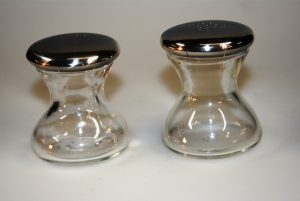Duranglas: "Max + Moritz" - German/German

Who doesn't know them - the well-known "Max and Moritz" salt and pepper shakers by Bauhaus student, professor and industrial designer Wilhelm Wagenfeld. He designed them in 1953 for the Geislingen-based Württembergische Metallwarenfabrik, or WMF for short. Wagenfeld's goal was to create usable household tableware in a functional design: without superfluous flourishes, suitable for mass production and affordable for every customer.
This is also how "Max and Moritz" present themselves: Their shape gives them stability. The constriction in the middle loosens salt and pepper and keeps it spreadable. The large opening makes filling easier and the push-on lid can be removed and replaced with a simple press.
Wagenfeld first became involved with glass as a material in the 1930s, when he worked in Jena as artistic director for the Schott und Genossen glassworks in Jena. His designs, such as the glass tea service, the egg cooking glass or the series of fireproof vegetable and baking bowls, were style-defining and can still be found in almost every household today.
In the 1920s, borosilicate glass, duran glass, invented by Otto Schott, found its way into households under the name "Jenaer Glas". The transparent, extremely heat- and temperature-resistant glass had previously conquered the world's laboratories as "Jenaer Geräteglas". With the mass production of glass cylinders for the paraffin lamp, Schott became a major industrial enterprise. But with the introduction of the light bulb, the production of glass cylinders faced such competition that new market niches had to be found: In the style of the Bauhaus, designers such as Heinz Löffelhardt, Gerhard Marcks and Wilhelm Wagenfeld now designed a new household glass made of fireproof Jena glass. They marketed it under the slogan "From the cooker to the table".
Pyrex Glass: "Max + Moritz" - English

You may or may not recognise the well-known "Max and Moritz" salt and pepper pots designed by the Bauhaus student, professor and industrial designer, Wilhelm Wagenfeld. He designed them in 1953 for the Württemberg metal ware factory, WMF for short, in Geislingen. Wagenfeld's aim was to create workable designs for useful household condiments, without superfluous flourishes that were suited to mass production and everybody's pocket!
Thus "Max und Moritz," have a robust shape that narrows in the middle that stops the salt and pepper grains getting stuck together and allows them to be easily sprinkled. The large opening makes refilling easy and the pressure lid can be opened with a simple press and put back on in the same way.
Wagenfeld first got to grips with glass when he worked as the artistic director of the Jena Schott & Associates Glassworks in the 1930s. His designs, such as the glass tea service, egg timer or the heat-resistant vegetable and baking form series were trend setting and can still be found in almost every household today.
Borosilicate glass invented by Otto Schott during the 1920s, otherwise known as duran or pyrex glass, found its way into the German household under the name of "Jenaer Glas". Before this the transparent, extreme heat and temperature resistant glass had conquered the laboratories of the world as "Jenaer technical glass. Schott became a large industrial concern with the production of glass cylinders for paraffin or kerosene lamps, but when the light bulb was introduced; the production of glass cylinders was presented with such strong competition that new market niches had to be found. So, designers such as Heinz Löffelhardt, Gerhard Marcks and Wilhelm Wagenfeld designed Jenaer, heat-resistant glass in Bauhaus style for everyday use at home... And they marketed this under the slogan: "from the oven to the table."